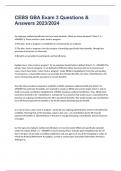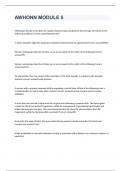CEBS GBA Exam 3 Questions &
Answers 2023/2024
An employee welfare benefit plan has four basis elements. What are these elements? (Mod 1.1) -
ANSWER-1) There must be a plan, fund or program.
2) The plan, fund or program is established or maintained by an employer.
3) The plan, fund or program is for the purpose of providing specifically listed benefits, through the
purchase of insurance or otherwise.
4) Benefits are provided to participants and beneficiaries.
Explain how a "plan, fund or program" for an employee benefit plan is defined (Mod 1.1) - ANSWER-The
phrase "plan, fund or program" is not defined in ERISA but rather has been laid out in several court
cases. Courts have held a "plan, fund or program" under ERISA is established if, from the surrounding
circumstances, a reasonable person can ascertain the intended benefits, the class of beneficiaries, the
source of financing and the procedure to receive benefits.
Describe the procedures required to establish an ERISA employee welfare benefit plan (Mod 1.1) -
ANSWER-No particular formalities are required to create an ERISA plan and no single action in and of
itself necessarily constitutes establishment of ERISA employee welfare benefit plan. Thus, ERISA plans
have been deemed to be "established or maintained" by a practice that would cause a reasonable EE to
perceive an ongoing commitment by the ER to provide EE benefits. This would include any contributions
by an ER toward payment of benefits or by the ER simply administering the benefit.
It is easy to have a plan, fund or program - generally any ongoing administrative scheme will satisfy this
condition. Showing that an ER maintains a plan is also easy - any contribution by the ER towards
payment of benefits or administration of the plan is enough (including a contribution toward insurance
coverage).
List the types of employee welfare benefit plans not covered under ERISA and specifically excluded
under the statute (Mod 1.1) - ANSWER-1) Governmental Plans: includes plans established by the US
Gov't, the gov't of any state or political subdivision and any agency of any of the foregoing or a plan to
which the Railroad Retirement Act applies, as well as certain plans associated with Native American
Tribal gov'ts.
,2) Church plans: a plan established and maintained for its EE's by a church or by a convention or
association of churches is exempt from tax under IRC Sec 501.
3) A plan maintained to comply with state laws on Worker's Comp, Unemployment or Mandated
Disability Insurance.
4) A plan maintained outside the US primarily for nonresident aliens.
5) Plans that cover only self-employed individuals and that cover no "common-law employees" generally
not subject to ERISA.
6) Plans that cover only married shareholders of a corporation are not treated as ERISA plans.
ER should be aware that is may be required to comply with other federal laws that affect EE benefit
plans.
List the types of benefits provided by ERISA health and welfare, and provide examples of such plans
(Mod 1.1) - ANSWER-a) Medical, Surgical or Hospital Care or Benefits
b) Benefits in the event of sickness, accident, disability, death or unemployment
c) Vacation Benefits
d) Apprenticeship or other training benefits
e) Day-care centers
f) Scholarship funds
g) Prepaid legal services
Ex: Medical Insurance, Dental, Vision, Prescription Drug Plans, Drug or Alcohol Treatment programs,
FSAs, EAPs, Wellness Programs, AD&D and STD/LTD Plans.
Discuss whether plans that involve payroll practices are treated as ERISA health and welfare plans (Mod
1.1) - ANSWER-The payment of an employee's normal compensation in full or in part out of the
employer's general assets for periods when the employee is physically or mentally
unable to work—that is, an unfunded short-term disability plan—is generally not a
welfare benefit plan subject to ERISA. However, if a disability program provides
more than an employee's normal compensation or is funded in any way—for
example, it is provided through insurance - the program will be a welfare benefit plan subject to ERISA.
,The Dept of Labor (DOL) regulations list additional types of payroll practices as not being ERISA plans.
These include plans where compensation is paid to an EE:
a) While absent on holiday/vacation
b) While absent on active military duty
c) While absent for jury duty/witness
d) On account of periods of time during which the EE performs little or no work while in training
e) EE is relieved of duties while on sabbatical leave or while pursuing further education.
For a voluntary benefit arrangement to be exempt from ERISA based on the DOL safe harbor, it must
meet certain requirements, which are? (Mod 1.1) - ANSWER-a) No ER or EE organization contributions
b) Participation is completely voluntary
c) No ER consideration except for reasonable compensation and administration
d) No employer endorsement
Explain the meaning of the term "no employer endorsement" (Mod 1.1) - ANSWER-Means an ER can
publicize, collect premiums, remit premiums, provide employee information to an insurance company
and maintain a
file on the voluntary plan. However, an employer cannot express positive normative
judgment and cannot urge/encourage employee participation. The participation of
the employer or employee organization should be limited to the duties specified in
the regulation, none of which involve the exercise of discretionary duties. An
employer hoping to rely on this exemption should also be careful not to create the
impression that the benefit is part of its benefit package by, for example, including it
in enrollment materials or encouraging employees to enroll. DOL warns in the final
Family and Medical Leave (FMLA) regulations that if a plan is intended to be
exempt from ERISA under this provision, the ER should not pay an EE's premium while the EE is on FMLA
leave.
Define each of the following ERISA terms:
, a) plan administrator/sponsor
b) participant
c) beneficiary (Mod 1.2) - ANSWER-(a) Plan administrator/plan sponsor
A plan administrator is a person with statutory responsibility for ensuring that all of the required filings
with the federal government are timely made and is the person upon whom the statute imposes
authority to make important disclosures
to participants about plan benefits. Generally, the plan administrator is designated in the plan document.
However, if the plan administrator is not so designated, then the responsibility defaults to the plan
sponsor, which is usually
the employer. Generally, in a single employer situation, the employer is the plan sponsor. Therefore, the
employer is ultimately responsible for all reporting and disclosure requirements and should implement a
process to make certain those responsibilities are followed.
b) Participant:
The term participant has been interpreted broadly to include employees in, or reasonably expected to be
in, currently covered employment. This would include employees who are eligible for a plan but who are
not enrolled. However, employees in a class not eligible to participate in a plan are not participants
under the ERISA definition. In addition, because the definition is not limited to current employees, it can
include COBRA-qualified beneficiaries, covered retirees and other former EE's who may remain eligible
under a plan.
(c) Beneficiary:
A beneficiary is any person designated by a participant (or by the terms of an ERISA plan) who is or may
become entitled to a benefit under the plan. A beneficiary has rights provided under the plan in
question, and the plan
fiduciaries owe fiduciary duties to plan beneficiaries as well as to plan participants. A beneficiary may
sue under ERISA for plan benefits and to remedy ERISA violations. A beneficiary also has the right to
examine and
request copies of plan documents.
What are the main disclosure requirements under ERISA? (Mod 1.2) - ANSWER-(a) A plan document
must exist for each plan
(b) A summary plan description (SPD) must be furnished automatically to participants





